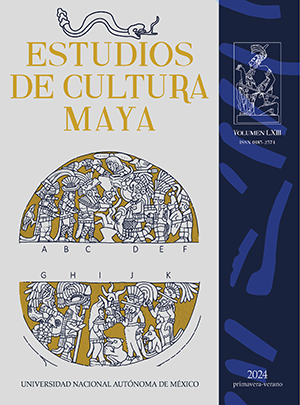U T’aan Nukuch Máak (‘Words of the Elders’): Defining a Yucatec Maya ‘Speech’ Genre
Contenido principal del artículo
Resumen
Yucatec Maya orality has been a popular topic of study of scholars from a wide array of disciplines. These studies often rely on academically generated categories of speech that have often been stylized in forms that descend from Western thought. The generated speech categories may overlook more performance-based forms that are more common of Indigenous knowledge systems. Most of the collected and analyzed Maya oral literature appears to be recounted by men, leaving women’s orality and their unique ways of interpreting the world largely under-documented. In this paper, I expand our understanding of Yucatec Maya women’s oral literature by providing a systematic documentation and description of u t’aan nukuch máak, words of the elders, a ‘speech’ genre that relies largely on performance. The performance of u t’aan nukuch máak are an embodiment of my female collaborators’ culture, as they occur in their daily routines. U t’aan nukuch máak are performed (or uttered) in the context of certain bodies, objects, times, and spaces that index concepts that reflect the strength of Maya cultural memory.
Detalles del artículo

Esta obra está bajo una licencia internacional Creative Commons Atribución-NoComercial 4.0.
El autor o autores se compromete(n) a firmar una declaración autorizando la publicación en los distintos soportes y espacios de difusión de Estudios de CulturaMaya y cediendo los derechos patrimoniales sobre la obra en forma total y exclusiva a la Universidad Nacional Autónoma de México, conforme a lo establecido en el artículo 84 de la Ley Federal del Derecho de Autor y demás relativos y aplicables a su reglamento, en el entendido de que será respetado su derecho autoral sobre la obra, se les otorgará el crédito correspondiente y recibirá(n) un ejemplar del número de Estudios donde aparezca el artículo
Citas
Arewa, E. Ojo, and Alan Dundes. 1964 “Proverbs and the Ethnography of Speaking Folklore”, American Anthropologist, 66 (6): 70-85.
Assmann, Jan. 2011 “Communicative and Cultural Memory”, Cultural Memories: The Geographical Point of View, pp. 15-27, Peter Meusburger, Michael Heffernan, and Edgar Wunder (eds.). London: Springer.
Bakhtin, Mikhail M. 1986 Speech Genres and Other Late Essays. Austin: University of Texas Press.
Bassie-Sweet, Karen. 2008 Maya Sacred Geography and the Creator Deities. Norman: University of Oklahoma Press.
Bricker, Victoria R., and Munro S. Edmonson. 1985 Handbook of Middle American Indians: Supplement 3 Literatures. Austin: University of Texas Press.
Bricker, Victoria R., Eleuterio Po’ot Yah, and Ofelia Dzul de Po’ot. 1998 A Dictionary of the Maya Language as Spoken in Hocabá, Yucatán. Salt Lake City: The University of Utah Press.
Briggs, Charles L. 1985 “The Pragmatics of Proverb Performances in New Mexican Spanish”, American Anthropologist, 87 (4): 793-810.
Burns, Allan F. 1983 An Epoch of Miracles. Oral Literature of the Yucatec Maya. Austin: University of Texas Press.
Callahan, Robey Kenneth. 2005 “Doubt, Shame, and the Maya Self ”, PhD in Anthropology. Philadelphia: University of Pennsylvania, Department of Anthropology.
Christenson, Allen J. 2007 Popol Vuj: The Sacred Book of the Maya. The Great Classic of Central American Spirituality, Translated from Original Maya Text. Norman: University of Oklahoma Press.
Csordas, Thomas J. 1990 “Embodiment as a Paradigm for Anthropology”, Ethos, 18 (1): 5-47.
Deriu, Fabrizio. 2020 “ ‘Action-Metaphor’. The Performatic Sources of Human Meaning-Making”, Signata. Annales des sémiotiques/Annals of Semiotics, (11), doi: 10.4000/signata.2712.
Domínguez Aké, Santiago. 1993 Ba’ax Ku Tukultiko’ob Maya Wiiniko’ob Ku Yuuchul. México: Instituto Nacional Indigenista.
Dundes, Alan. 1961 “Brown County Superstitions. The Structure of Superstition”, Midwest Folklore, 11 (1): 25-56.
Dundes, Alan. 1994 “On the Structure of the Proverb”, The Wisdom of Many: Essays on the Proverb, pp. 43-64, Wolfgang Mieder, and Alan Dundes (eds.). Madison: The University of Wisconsin Press.
Eberardo, Feliciano P. 1991 “Dichos en el idioma maya-mam de Guatemala como una estrategia para la transmisión de valores”, Past, Present, and Future: Selected Papers on Latin American Indian Languages, pp. 27-30, Mary H. Preuss (ed). Culver City: Labyrinthos.
Edmonson, Munro S. 1982 The Ancient Future of the Itzá: The Book of Chilam Balam of Tizimin. Austin: University of Texas Press.
Elmendorf, Mary. 1976 Nine Mayan Women. Rochester: Schenkman Pub. Co.
Gaskins, Suzanne. 1999 “Children’s Daily Lives in a Mayan Village: A Case Study of Culturally Constructed Roles and Activities”, Children’s Engagement in the World: Sociocultural Perspectives, pp. 25-61, Artin Göncü (ed.). New York: Cambridge University Press.
Gaskins, Suzanne. 2000 “Children’s Daily Activities in a Mayan Village: A Culturally Grounded Description”, Cross-Cultural Research, 34 (4): 375-389.
Gaskins, Suzanne. 2008 “Children’s Daily Lives among the Yucatec Maya”, Anthropology and Child Development: A Cross-Cultural Reader, pp. 280-288, Robert A. LeVine and Rebecca S. New (eds.). Malden: Blackwell Publishing.
Geertz, Clifford. 1973 The Interpretation of Cultures: Selected Essays. New York: Basic Books.
Gossen, Gary H. 1973 “Chamula Tzotzil Proverbs. Neither Fish nor Fowl”, Meaning in Mayan Languages: Ethnolinguistic Studies, pp. 205-233, Munro S. Edmonson (ed.). The Hague: Mouton & Co. N.V.
Grube, Nikolai. 2008 “Solar Eclipses-Fearing the End of the World”, Maya: Divine Kings of the Rainforest, pp. 144-147, Nikolai Grube (ed.). Potsdam: H.F. Ullmann.
Guerrettaz, Anne Marie. 2019 “Yucatec Maya Language Planning and the Struggle of the Linguistic Standardization Process”, International Journal of the Sociology of Language, 2019 (260): 61-83.
Kramer, Karen L. 2005 Maya Children: Helpers at the Farm. Cambridge: Harvard University Press.
Lawless, Elaine. 2019 Reciprocal Ethnography and the Power of Women’s Narratives. Bloomington: Indiana University Press.
León-Portilla, Miguel, and Jorge Klor de Alva. 2001 In the Language of Kings. An Anthology of Mesoamerican Literature, Pre-Columbian to the Present. New York: W.W. Norton & Company.
Mieder, Wolfgang. 2004 Proverbs. A Handbook. Westport: Greenwood Publishing Group.
Muntsch, Albert. 1943 “Some Magico-Religious Observances of the Present-Day Maya Indians of British Honduras and Yucatan”, Primitive Man, 16 (1/2): 31-43.
Otzoy, Irma. 1992 “Identidad y trajes mayas”, Mesoamérica, 13 (23): 95-112.
Palmer, Hannah. 2019 “Writing Maya Women. Representations of Gender in Contemporary Yucatec. Maya Literatures”, PhD in English and Comparative Literature. Chapel Hill: University of North Carolina, Department of English and Comparative Literature.
Paradise, Ruth and Barbara Rogoff. 2009 “Side by Side: Learning by Observing and Pitching In”, Ethos, 37 (1): 102-138.
Park Redfield, Mary. 1935 The Folk Literature of a Yucatecan Town. Publication 456, Carnegie Institute of Washington. Washington, D.C.
Peterson, Jeanette Favrot. 2021 “Rhetoric as Acculturation. The Anomalous Book 6”, The Florentine Codex. An Encyclopedia of the Nahua World in Sixteenth-Century Mexico, pp. 167-183, Jeanette Favrot Peterson, and Kevin Terraciano (eds.). Austin: University of Texas Press.
Preuss, Mary H. 2005 Yucatec Maya Stories: From Chen-Ja’ to the Milpa. Lancaster: Labyrinthos.
Raby, Dominique. 2007 “The Cave-Dwellers’ Treasure. Folktales, Morality, and Gender in a Nahua Community in Mexico”, Journal of American Folklore, 120 (478): 401-444.
Rhodes, Catherine R. 2020 “Dually Authenticated and Doubly Modern. Institutionalizing Jach Maaya in the Yucatan Today”, Journal of Linguistic Anthropology, 30 (3): 326-352.
Rosenbaum, Brenda. 1993 With Our Heads Bowed. The Dynamics of Gender in a Maya Community. Albany: Institute for Mesoamerican Studies.
Roshan, Anupama S., C. Janaki, and B. Parveen. 2009 “White Piedra in a Mother and Daughter”, International Journal of Trichology, 1 (2): 140.
Sachse, Frauke. 2021 “Metaphors of Maize. Otherworld Conceptualizations and the Cultural Logic of Human Existence in the Popol Vuh”, The Myths of the Popol Vuh in Cosmology, Art, and Ritual, pp. 48-76, Frauke Sachse, Allen J. Christenson, and Holley Moyes (eds.). Boulder: University Press of Colorado.
Sahagún, Bernardino de. 1981 Florentine Codex - Book 4 - The Soothsayers and Book 5 - The Omens. Charles E. Dibble and Arthur J. O. Anderson (trads.). Salt Lake City: The University of Utah Press.
Sharer, Robert J. 1994 The Ancient Maya. Fifth ed. Stanford: Standford University Press.
Sheedy, Crystal. 2019 “The Everyday Sacred. A Symbolic Analysis of Contmeporary Yucatec Maya Women’s Daily Realities”, PhD in Anthropology. Albany: State University of New York at Albany, Department of Anthropology.
Sosa, John R. 1995 “Maya of Yucatán. The Sacred in Everyday Life”, Portraits of Culture: Ethnographic Originals, pp. 257-282, Melvin Ember, Carol R. Ember, and David Levinson (eds). Englewood Cliffs: Prentice Hall.
Strathern, Andrew, and Pamela J. Stewart. 2008 “Embodiment Theory in Performance and Performativity”, Journal of Ritual Studies, 22 (1): 67-71.
Stross, Brian. 2006 “Maize in Word and Image in Southeastern Mesoamerica”, Histories of Maize. Multidisciplinary Approaches to the Prehistory, Linguistics, Biogeography, Domestication, and Evolution of Maize, pp. 577-598, John Staller, Robert Tykot, and Bruce Benz (eds.). New York: Routledge.
Taylor, Diana. 2003 The Archive and the Repertoire. Performing Cultural Memory in the Americas. Durham: Duke University Press.
Tedlock, Dennis. 1996 Popol Vuh. The Mayan Book of the Dawn of Life. Revised ed. New York: Touchstone.
Worley, Paul M. 2013 Telling and Being Told: Storytelling and Cultural Control in Contemporary Yucatec Maya Literatures. Tucson: University of Arizona Press.
Worley, Paul M., and Rita M. Palacios. 2019 Unwriting Maya Literature: Ts’íib as Recorded Knowledge. Tucson: University of Arizona Press.






